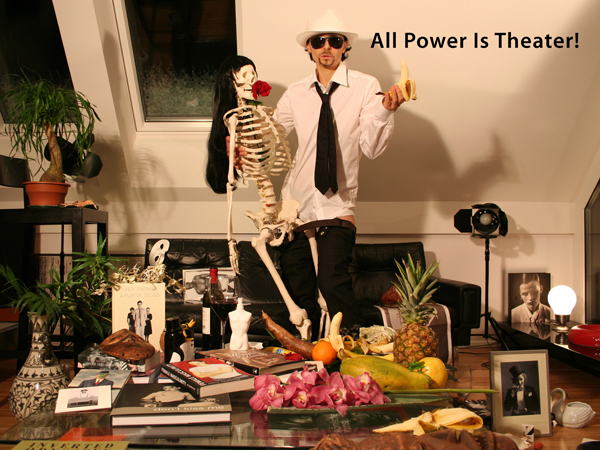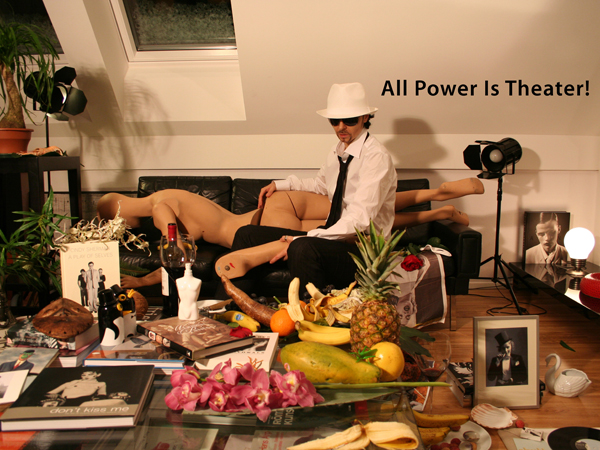home > new and ongoing > timeline
- - - <бг>
code flow - events
9-30 June 2008
open-air exhibition of the shortlisted contributions in front of the Ivan Vazov Theater, Sofia, Bulgaria
ten of the works in the exhibition will be selected to be realized as billboards in the streets of Sofia later in the year
featuring among the shortlisted contributions Dimitrina Sevova's project "All Power Is Theater! Female Masculinity"
Before 9 June 2008: If you like the works presented here, please feel free to vote online and give them five stars (click on the right-most star of the poll) directly in the gallery of the project. Thanks!

Dimitrina Sevova
All Power Is Theater! Female Masculinity #1, 2008.
All Power Is Theater!
After the drag queen performance of “Marcel Duchamp as Rrose Sélavy,” a photographic sequence of three self-portraits by the woman artist Dimitrina Sevova as a drag king in collaboration with code flow.
The sequence of photographs is inspired by the book “Female Masculinity” by Judith Halberstam, Duke University Press, Durham and London, 1998.
“The aggressive libido (or libidinous legends) of the emperors became itself a statutory sexual role allotted to the prince. […] Only he had the absolute right over both the female and the male body.”
Pascal Quignard, Le sexe et l’effroi (Sex and Horror; no English translation published), Editions Gallimard, 1994 (p. 40).
“Dada was born of a revolt common to all young people, demanding of them the complete identification of the individual with the deep aspirations of its nature without regard to history, logic, or morals,” Tzara later said of the artistic movement that had paved the way for the new art. After the artistic movement Dada, it was the Surrealists who sought ways to discover and explore an unknown reality that plays an enormous role in the life and behavior of people, even if they may not be aware of it. A linguistic revolution according to Breton, who claims that surrealism was born out of a huge clandestine operation against language – to discover the secrets of a language whose elements would not act as the remainders of a shipwreck on the surface of a dead sea.

Dimitrina Sevova
All Power Is Theater! Female Masculinity #2, 2008.
In this group of destroyers of all sorts of norms and rules one can recognize the figure of the man with a bowler hat, formal suit, white shirt, bow-tie and black umbrella – René Magritte who had embraced all the attributes of bourgeois masculinity of his time in order to lead this construction to its utter collapse from the pedestal of its dominating position. He is the author of “This is not a pipe,” “Ceci n’est pas une pipe”, a painting of unspectacular size. It represents the image of a pipe painted with precision in classic oil technique, under which a text in careful calligraphic letters reads: “This is not a pipe.” This small canvas breaks up petrified notions and marks a new stage of art. Beyond its aura as a cult object to be emulated, the revolutionary force of this in itself unseemly painting lies in the uncovering of a technique with which for the first time the boundary between linguistic signs and plastic elements, i.e., the border between sign and image, was deliberately wiped out. This method is discussed and developed later by Foucault as “Non-affirmative Painting.” The technique of “Non-affirmative Painting” makes use of the confrontation of the linguistic structure of the slogan, which emulates, imitates, parodies the image, turning the meaning of the painting around. Rather than the initial meaning: “This is a pipe,” in its silently hidden mimicked representation it diffuses the opposite message: “This is not a pipe.” The approach is theoretically developed by Foucault in a publication bearing the same title as the artist’s painting, published in French in 1982. He proves that painting can serve explosive conspiratorial practices. Jean Baudrillard uses similar technologies in his guerilla communication as he looks at the theory of art under this angle. As do most artistic movements, such as the Pop Art artists, the Situationists or the Cyber Feminists. “Monsieur René Magritte”, a film by Adrian Maben from 1978, shows how Magritte besides painting experimented with 8mm film, strongly influenced in this by the sketches of the comics Stan Laurel and Oliver Hardy who were also moving among the unaffirmed discourses of fake masculinity and heterosexuality. The similar appearance of Magritte and the comics, brought to a parodic performance of self-staging, of self-quoting, plays the same role in the deconstruction and blotting out of the sexual roles imposed by heteronormative rules and polar definitions like male and female, as they were brought out by Adler, and which continue to underpin to this day the fundamental social dynamics.

Dimitrina Sevova
All Power Is Theater! Female Masculinity #3, 2008.
This technique of subversive affirmation can be found also in the image of hyper-femininity of Madonna in the 1980s, which is so caricatural that it is perceived with an opposite sign and falls apart. Magritte painted images like that of the man with an apple for a head, the man with the luminous head, as he himself was self-staging, self-painting himself continuously blotting out the border between his daily life and his art. He enjoyed order, was very humble, didn’t like traveling and did so only when forced to, two or three times in his lifetime, was thrifty, moderate, almost never used an automobile, moved around on his bicycle, preferred painting in his living room near the window in the midst of the bourgeois interior of his own provincial house to working in his studio. He remained married and faithful throughout his life to one and the same woman whom he had been seeing already at the early age of 14 and who has been his only model and served as the prototype for all female figures in his paintings from the beginning to the end of his career as a painter. Fame came to him only at the end of his 50s. His living room was crammed with a vast collection of all sorts of clocks tick tacking in synch, fully accurate, while he himself led an orderly life in which he worked according to a strict time schedule that would be more characteristic of a bank clerk. Every day for more than 50 years he painted every day for eight hours, pausing at lunch to eat the hot soup his dear wife had cooked. Such a contradiction, one of the most provocative artists of all times like Kafka’s hero in “The Castle” finds himself constricted, continuously walking about the labyrinth of his own consciousness, suggesting that the key to freedom is an internal category, not an outward attribute. Just like the comics Laurel and Hardy, Charly Chaplin constructed his entire work around a deheroized and parodic masculinity. Another famous comic figure representing traditions and patriarchal norms by parodically imitating masculinity is the father in Disney’s cult production, the musical film “Mary Poppins” (1964) featuring the actress Julie Andrews. The character of this parodic fake, orderly, hard-working, strict, paranoid father is contrasted with the merry, frivolous character of the suffragette mother and the witch Mary, who mixes up the directions and creates temporary panic and chaos in which the signing of the social contract is reiterated. In the happy merriment of amusement-park fun, harmony and peace and quiet are reestablished. The statutory role and function of this social construction is found again.
Kafka centers his work on the observation of the character of the stifled, deheroized, ordinary, useless, orderly and boring man. The role of the frustrated and paranoid figure of the father or the lonely human figure reminiscent of Sisyphus appearing continuously in Ilya Kabakov’s drawings and installations is similar. In his installation from the series of unrealized projects “My father’s house” the figure of the father is rather the constitution of an absence. The father who does not want to leave his lonely house in the valley is hiding in the construction of what the author calls “animist” or “animal” architecture. The building resembles the suspicious snout of a lone wolf living in the empty steppe, the father who is hiding away, filled with animosity and fear, behind the windows of his own fortress, walking from room to room, turning into a passive and lonely observer of his own life. The French director Jacques Tati makes use of the same image of this social construction in order to build up the main character of his films, the caricatured figure of a heterosexual ordinary white man who appears as exotic and out of place in the new economic and social order as the exotic figure of the black migrant. With his shabby raincoat, shortish pants, wrong-sized bucket hat worn askew and battered jacket, nothing of this character at all is in its place. His behavior is just as inadequate as his appearance. He is himself confused, and never knows which direction to go, is roaming, creates confusion, a total mess and dizziness wherever he shows up in public space. Breaking things and tripping over everything that comes into his reach, continuously running after some unreachable female, some superwoman, some total, super-elegant, knowledgeable and able blonde on high heels who moves in the waters of this new economy like a tiger shark. Tati’s method is similar to that of Magritte. He does not seek extreme or risky sexual constructions, such as black, migrant, gay, in order to show situations of exclusion, that something is happening to society itself, that something is not right. The fact that the representative figure of the dominating discourse is unable to find its place in a highly technologized, gentrified new economic and social order is a strong argument in his critique. Bergmann in “Fanny and Alexander” uses the same technique in order to examine the construction of the Self.
In Camus’ short story “The Stranger,” once again we come across this specific sham subject, as the main character is built on the matricial figure of deliberate, emphatic normality. Meursault embodies the stereotypical character of the white, young, healthy, heterosexual, plain normal man who has found his own existential freedom from the systems of control through the technology of escaping, of non-appearance, of absence in a passive non-resistence. Without lying to himself, without performing himself, he “The Stranger” turns out to be just a passive observer of his own life. Alienated from life, without illusions, alienated from his desires, alienated from hope, he does not follow the rules, not because he breaks them but because he is absent. This very figure ends up at the center of a farcical court case in colonial Algeria. The comedy of life, the absurdity of daily life puts Meursault face to face with death. A trivial marginal person, a trivial marginal killing end up at the center of a public spectacular court case, as food for the press. Sentenced to death by a racist court for killing an Arab who means nothing to the colonial power, for killing someone who for the colonial society incorporates the essence of otherness, and whose death is of no great interest to it. How absurd! The hero is sentenced to death not because he has killed someone, but because he refuses to participate in the spectacle, the theater of power. He identifies neither with the audience nor with the main actor. He is just not there. He is an absence. Meursault is executed because he is fundamentally as undefined, indeterminate, unclear, ambiguous, unidentified as the otherness – articulated by this society – of the Arab he killed. No question that the crime is horrible, but the fundamentality of the crime, the brutality is inescapable, and it is hypocrisy to avoid it at any cost, according to Julia Kristeva in her novel “Possessions: A Novel.” Camus created this existentialist provocation in order to criticize the dominant power, but also to show that something is deeply out of order, fundamentally not right with society. Some feminist artists made use of the same technique, following Magritte’s method, like Cindy Sherman or Maya Deren, in order to tear apart the no less sham construction of femininity.
With their newest film “No Country for Old Men” the Coen brothers deheroize the figure of the superman of Western films, like those embodied by John Wayne. The death of the main hero is presented by the Coen brothers as something incidental, mentioned casually among other things. In the end, only the old male prototype of super-masculinity remains. Unlike in the construction of the myth of Ulysses there is no continuity. In this new world there is no place for such a social construction. At the end of the film, without having found revenge, without having won, without dominating, the super-masculine hero, frustrated, goes into retirement – and the young hero is dead. In any event this construction of super-masculinity has long become rather a symbol of homosexual erotic, not only in box office success films like “Brokeback Mountain,” where the strong men turn out to have tender hearts. The punk aesthetic also thoughtfully spreads T-shirts with this message in underground nightclubs.
Before Dada and the Surrealists it was Freud who, despite explicitly propagating a philosophical dualism directly fitting the Western tradition, according to Julia Kristeva was the first to develop through his notion of the “psychic apparatus” a theoretical construct that cannot be reduced to the body, subject to the influence of nature, but that at the same time can be observed in linguistic structures. The other great merit of the father of psychoanalysis is the discovery of a bisexuality deeply engrained in human nature, a corroboration of the Darwinian definition of human beings as hermaphrodite beasts.
Gender manifests itself like a machine-ventriloquist, according to anthropologists. In every society sexuality turns out to be coerced by its own lexical means, the body, to produce discourses that do not result from its nature and go far beyond its bounds, because they concern the universal social order, which forces it into submission. Gender is a manifestation of language, legitimizing realities that have nothing to do with sexuality.
The ideal of the androgynous beauty imposes itself in Romanticism and Modernism. What is androgynous in the hermaphrodite ideal of unvanquished youth are the faces of the revolution. The black angel of decadence, a figure of sexually blurred beauty, Marlene Dietrich turned into an icon of the new female beauty combining the jumbled-up codes of fatal femininity with a strongly masculinized presence. The postmodern shift of the codes follows Roland Barthes’ suggestion not to attempt to destroy the codes but rather to make them dance.
Contemporary fashion and the fashion industry are the new arena of emancipation, the dream factory, the sham new masculinity and new femininity, where a resourceful wallet will permit you to quickly shop, in Dionysian euphoria, for the required props like in a supermarket.
The parents of punk, metal and the new image of the rebellious youth against bourgeois preconceptions, which remains of interest and active to this day, are the New York based musical band of the 1970s “New York Dolls.” “Doll,” in English, can be used, besides for a chick, a girl, also for a “smart boy,” a cute guy dressed up to the nine (in other words, dolled up). They devised the new image of the dauntless youth. The one that contains the other, too, a multilayered identity combining polar norms, juggling with them without ever choosing one of the poles – besides the subversive affirmation of kitsch from the entertainment and amusement industry. They fit into the so-called camp culture, a term introduced into mainstream use by Susan Sontag in order to define an aesthetic that takes off from kitsch to go beyond, creating its hyper-kitsch oversize copy. The new camp aesthetic defines the new tendencies in the new art. Artists like Jeff Koons or Andy Warhol operate with this language, as well as the new wave of transgressive cinema and art introduced by the New York based director of author cinema Nick Zedd, strongly influenced by the Russian linguist Bakhtin and his theory of the carnivalesque.
In pop culture and youth movements like punk, rock, metal, which boast an ideal embodying androgyny, both the face of the revolution and the face of power are always androgynous. Just like the Queen Margot paints her face in white and achieves a masculine appearance by wearing the mask of power in order to secure herself the respect of her subjects, Mick Jagger claims: “Everything is fake, everything goes!” David Bowie, another subversive icon of alternative culture, uses his own physiological asymmetry and genderless appearance in order to bring out the figure of the rebellious angry young person. Marilyn Manson makes use of similar strategies. From the punk diva Patty Smith through Laurie Anderson to Yoko Ono and Annie Lennox, they all play with female masculinity, displace the gender codes and make them dance, breaking social and cultural taboos in order to open up more space for freedom.
The notions of male or female are social and linguistic constructs, claims Judith Butler in her theory of the performative, i.e., the acting out of gender is a continuous performance. Man Ray made a portrait of “Marcel Duchamp as Rrose Sélavy”, 1920-1921. Matthew Barney in his film saga “Cremaster” similarly deconstructs gender. Artists from Claude Cahun to Adrian Piper have experimented with gender constructions, performing drag king roles.
Just like the cyber-feminist theorist Donna Haraway sees the emancipatory force in the new phenomenon of the scattering of gender in a profusion of diverse new genders, the gender theorist Judith Halberstam invokes the right of all genders to exist on equal terms. She claims that masculinity, just like femininity, must be given the right to exist. With an important note: masculinity is no longer to be something reserved to those human beings biologically determined to be of male sex. Judith Halberstam declares female masculinity’s right to exist.

